Chapter: Health Management in Aquaculture: Environmental and other non-infectious diseases
Shrimp Diseases Associated With Physico-Chemical properties of Water
SHRIMP DISEASES ASSOCIATED WITH PHYSICO-CHEMICAL PROPERTIES OF WATER
Muscle Necrosis
Muscle necrosis in shrimp is caused by temperature and salinity shock, low oxygen levels, overcrowding, rough handling and severe gill fouling.
SIGNS:
Affected shrimp show opaque white areas on the abdomen (Fig. 6-3); blacken-ing on the edges of the uropod followed by erosion and liquid-filled boils at the tip of uropods in advanced stages; “wood grain” appearance of abdominal muscle in postlarvae (Fig. 6-4).
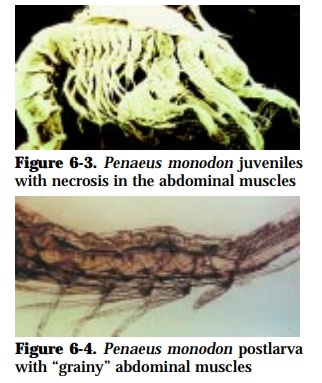
EFFECTS ON HOST:
There is a gradual death of cells of affected parts leading to erosion especially in the tail. This may then serve as portal of entry for secondary systemic bacte-rial infection.
PREVENTION AND CONTROL:
Reduce stocking density and improve water quality by daily water change (5-10%)
Bent/Cramped Tails or Body Cramp
Bent/cramped tails or body cramp in shrimps is associated with handling of shrimp in warm, humid air much warmer than culture water, and mineral imbalance.
SIGNS:
Affected shrimps have partial or complete rigid flexure of the tail (Fig. 6-5).
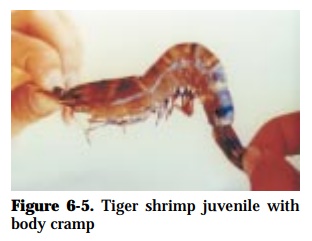
EFFECTS ON HOST:
Partially cramped shrimps swim with a humped abdomen; fully cramped shrimps lie on their sides at the pond/tank bottom. Healthy shrimps may can-nibalize weak ones.
PREVENTION AND CONTROL:
Avoid possible causes.
Incomplete Molting
Incomplete molting is closely associated with low temperature of culture water.
SIGNS:
Presence of old exoskeleton attached to newly molted larvae, especially in ap-pendages (Fig. 6-6).
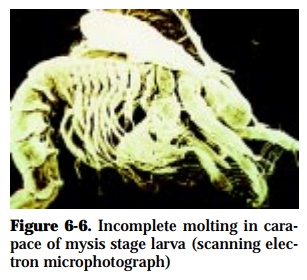
EFFECTS ON HOST:
Abnormal swimming movement which could lead to easy predation and mor-tality.
PREVENTION AND CONTROL:
• Maintain optimum temperature in the rearing water
• Use water heater
Asphyxiation/Hypoxia
Reduced dissolved oxygen due to high organic load or algal bloom and subse-quent die-off and high temperature
SIGNS:
Affected shrimp showed surface swimming and sudden mass mortality.
EFFECTS ON HOST:
Prolonged respiratory distress leads to death and sublethal levels may cause impairment of metabolism resulting in growth retardation.
PREVENTION AND CONTROL:
• Decrease stocking density
• Monitor water parameters frequently
• Provide aeration facilities and water pump for ready water change
Acidosis/Acid Sulfate DiseaseSydrome
Acidosis is caused by low water and soil pH
SIGNS:
Affected shrimp show poor growth, low molting frequency and yellow to or-ange to brown discoloration of the gill and appendage surfaces. The pond soil turns reddish in color (Fig. 6-7).
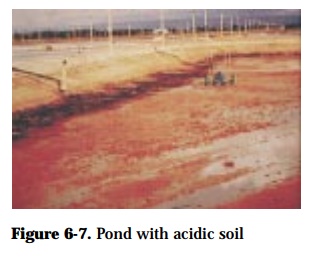
EFFECTS ON HOST:
Normal metabolism is hindered resulting in retarded growth and eventual death.
PREVENTION AND CONTROL:
• Monitor the pH
• Apply lime and flush the ponds before stocking
Black Gill Disease
Black gill disease is due to chemical contaminants, heavy siltation and ammo-nia or nitrite in rearing water; high organic load due to residual feed, debris, and fecal matter on pond bottom (i.e. black soil).
SIGNS:
The gills of affected shrimps show reddish, brownish to black discoloration and, in advanced cases, gill filaments become totally black (Fig. 6-8).
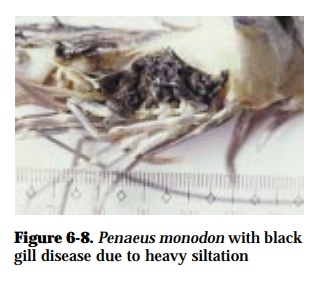
EFFECTS ON HOST:
Histological observations show that blackening of the gills may be due to the deposition of melanin at sites of tissue necrosis and heavy hemocyte activity.
PREVENTION AND CONTROL:
• Avoid heavy metal discharges of nearby factories from getting into the rear-ing facilities
• Remove black soil by scraping after each harvest and by draining pond wa-ter from the bottom during the culture period
Red Disease
Red disease in shrimps is associated with high application of lime (2-6 tons/ha) in the pond that gives it a high initial pH; prolonged exposure to low salinity (6-15 ppt).
SIGNS:
Affected shrimps have red short streaks on gills or abdominal segments, yel-lowish to reddish discoloration of the body (Fig. 6-9) and increased fluid in the cephalothorax, emitting foul odor.
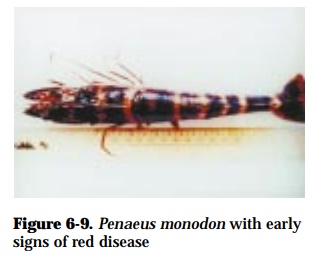
EFFECTS ON HOST:
Yellow to red discoloration in affected shrimps; histopathology of the hepato-pancreas shows hemocytic infiltration in the spaces between the tubules; more advanced lesions are in the form of fibriotic and melanized encapsulation of necrotic tissues, either in the tubule itself or the sinuses around it.
PREVENTION AND CONTROL:
• Prepare pond bottom properly
• Reduce lime and organic matter content inputs
Chronic Soft-Shell Syndrome
Chronic soft-shell syndrome is associated with exposure of normal hard-shelled Soft-Shelling shrimps to pesticides and piscicides. Aquatin at 0.0154 - 1.54 ppm, GusathionA at 1.5 - 150 ppb, rotenone at 10-50 ppm, and saponin at 100 ppm for 4 days can induce soft-shelling in initially hard-shelled stocks.
SIGNS:
Shell is thin and persistently soft for several weeks, shell surface is often dark rough and wrinkled, and affected shrimps are weak. The disease must not be confused with the condition of newly-molted shrimps, which have clean smooth, and soft shells that harden within 1-2 days.
EFFECTS ON HOST:
Affected shrimps are soft-shelled, grow slowly, and eventually die; histopathol-ogy of shrimps exposed to Gusathion A shows slight hyperplasia of the gill epithelium, delamination of the cells lining the tubules of the hepatopancreas, and general necrosis and degeneration of these tissues.
PREVENTION AND CONTROL:
• During pond preparation, flush ponds thoroughly particularly when pesti-cide contamination is suspected
• Maintain pond water and soil of good quality
Related Topics